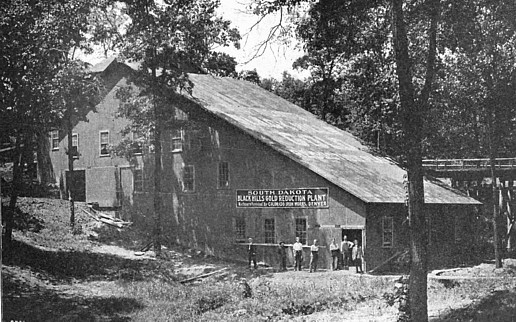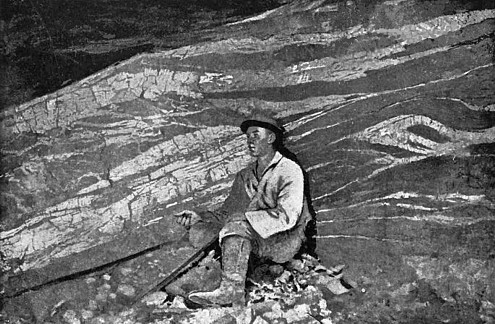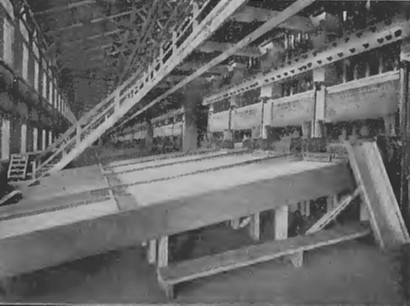The Homestake was among the first Black Hills properties bought in the interest of California capitalists, having been purchased by George Hurst, in conjunction with J. W. Gashwiler and Henry Janin, early in the month of April, 1878. The mine, which embraces a number of valuable claims, covers an area one thousand five hundred feet long by four hundred and fifty feet wide. The many tunnels and shaft openings in every part of it give evidence that the Homestake is one great, continuous body of paying ore. The most systematic and thorough developments have been made to test the real value of the property, and the result has been the erection of an eighty stamp mill, and another of one hundred and twenty stamps, and the preparation to work the mine by all appliances that will procure a steady yield of bullion. The north drift, from the vertical shaft on the one-hundred-feet level, is in over one hundred feet. It shows solid ore of a very rich character. In the Golden Star cut the breast has been widened. At one time a large body of talc slate, near the surface, was exposed to view, which assayed over fifty cents to the pound. How extensive this body may be is not known. At all points of the mine late developments show an increase and richness of the gold ore.
Over two hundred car loads per day are now run out over the tracks, thirty-four men working in the mine. The shots or blasts are enormous. Holes are opened by the aid of the best steam drills, and charged with enormous amounts of block powder, which tears down over a hundred tons of ore. Five hundred and twenty-five tons of ore per day is the average amount crushed. But if the cubic measurements made by mining experts are correct, there is enough ore now in sight to run five hundred tons a day for over five years. By means of an elevated tramway, over fifty feet above the ground, and supported by trestle-work, a track of "T" rails is laid into the top of the large one hundred and twenty stamp mill. An engine traverses this track from the mine to the mill, hauling as many cars of ore as may be desired. The building is one hundred and sixty by ninety feet. The sides thirty-two feet high, and the height from floor to the cone of the roof is seventy-eight feet. The framework throughout the entire structure is of the best selected Black Hills timber. Over one million feet of lumber was used in the construction, and one hundred and sixty-eight thousand shingles.
The celebrated Corliss engine, of three hundred horse-power, shipped from Providence, R. I., is the largest ever brought into the territories. It weighs eighty-nine thousand pounds, and has two flywheels fifty-six feet in circumference. The cylinder is twenty-six by twenty-eight inches, and the arm attached to the fly-wheel, weighs eight thousand six hundred pounds. The engine is set in the centre of one end of the building, and rests on eleven stones laid in hydraulic cement. These stones weigh eighteen thousand pounds each. Two line shafts on each side of the building have Walden & Mason's patent friction pulleys to drive the stamps. The great benefit of the patent friction pulleys is, that each ten stamps of the mill can be stopped by means of friction, the shoes being thrown in or out of gear by a lever without interfering with the motion of the mill. Three of Blake's largest size rock breakers are set in the top of the mill, so arranged that the rock when partially crushed passes to twenty-four of Hendy's patent self-feeders, placed in the rear of the stamps. The mortars are lined with copper and have improved screens. The stamps weigh eight hundred pounds each. The Hendy concentrator is a new feature in this part of the country. There are twenty-four of these placed at the end of each plate, so that, as a safe-guard, should any gold escape the battery or plate, it is saved by the concentrator. The tailings coming from the plates are run into the concentrator, which acts upon the same principle as we would pan out dirt by hand. This is only needed when the pyrite or sulfides of iron contain gold, as quicksilver will not act upon pyrites of iron. The machinery weighs over one million pounds, and the belting used weighs over three tons. The mill cost two hundred thousand dollars.
The hoisting machinery consists of two twelve by twenty-four engines of seventy-five horse-power, which are capable of raising two tons four hundred feet per minute ; two reels for hoisting, supplied with a steel wire cable which will sink the shaft to a depth of one thousand feet. . This cable is a most powerful and costly one, being two and three-fourths of an inch in diameter, weighing one pound and a quarter to the foot. Added to this is a six-inch drawing and lifting pump, with five-feet stroke, having a capacity of five thousand gallons per hour. The entire enterprise is one of immense proportions, and one that will be a profitable monument to the nerve and money of San Francisco capitalists. The Homestake Company has paid regular dividends of thirty cents per share on one hundred thousand shares, aggregating thirty thousand dollars monthly, for sixteen successive months up to April 1st, 1880, making a sum total of four hundred and eighty thousand dollars, which the mine has paid its shareholders in a year and four months.
The Caledonia Mine is opened by a tunnel which runs into the hill nearly at right angles with the ledge, which is reached at a distance of three hundred feet. At this point an immense chamber of ore has been excavated, and a shaft eighty feet deep connects this chamber with the surface. The main tunnel is being now driven along the foot-wall. It is about six hundred feet long, and at the north end a drift forty-five feet from the foot-wall to crosscut the vein, shows the face and side in solid ore and for the whole six hundred feet of this tunnel, the top, bottom and side show a continuous body of ore, the extent of which can be determined only by cross-cuts. One hundred feet below, and further down the hill, another tunnel has been started for the purpose of tapping the vein immediately under the large chamber, where connections will be made by means of a winze now being sunk. The lower tunnel is in about five hundred feet and has struck the ledge, a vein ten to twelve feet wide, which shows specimens of free gold. The company have a twenty-stamp mill which crushes about forty tons of ore per day, which averages nine dollars and fifty cents per ton. About thirty men are at work in the mine, but many more could be advantageously worked if necessary. The company expect to construct an eighty-stamp mill this season (1880) and assessments have been levied for that purpose.
The "Clara Consolidated," a mine lying parallel with the Caledonia, has been listed on the San Francisco stock board. It is opened by a tunnel, which is being driven into the hill as rapidly as possible. "The Golden Terra" Mine is a well-developed property. Over one thousand two hundred feet of tunnels and cross-cuts show up an enormous amount of ore in sight. One drift has a cross-cut one hundred and ten feet in length, which is in ore the entire distance. Another drift, running parallel with this main drift, shows the same character of ore. The main lower tunnel is in three hundred and sixty feet, and will run parallel to the upper tunnel, and be connected with it by winzes at convenient distances. Four veins have been cut in running the lower drift, one showing forty feet of ore, very similar to that on the lower level of the Father Desmet. This assays seventeen dollars per ton. At the surface the dirt from the grass roots down is being milled. A large breast of ore, two hundred feet wide, is exposed, which will be quarried down, and, by means of a chute into the tunnel below, transported by cars to the mill. A single blast has thrown down several tons of ore. No ore has been milled that did not yield from ten to twelve dollars per ton. The company are running a thirty-stamp mill, and are building another sixty stamp mill. About fifty men are worked in the mine.
In many cases the veins of gold quartz ore lie so near the surface that they have been opened by merely stripping off the thin layer of soil over them, exposing the ore which has been quarried out as from a great quarry, at small expense, and has paid for milling at the very grass-roots. These ledges of reddish-brown, iron-stained quartz, from fifty to two hundred feet wide, lying upon their edges between walls of slate, at an angle of about fifty degrees, are all ore from wall to wall, and is sent to the mill, in many cases, without selecting. The ore is easily blasted down in large quantities, and frequently the cost of shoveling it up into cars is saved by shooting it through a winze into cars in a tunnel below, where a track is lain to conduct the cars into the tops of the stamp-mills, where it is dumped into bins, and almost by its own gravity is fed automatically into the crushers and stamps below, saving a vast expense in labor. In this way the expense of mining and milling has been reduced to a trifle, as compared with the usual cost of handling ores. We would gladly, in this connection, devote more time to the description of the many rich mines in this vicinity, which for lack of space we are obliged to omit. We have, however, described some of the large ones, those most developed, which will give an idea of the vast deposits of ore which these Black Hills mines contain.
Return
to The South Dakota Page:
South Dakota Gold Rush History




